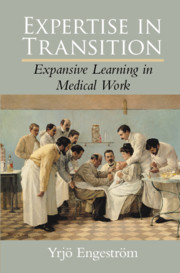Book contents
- Expertise in Transition
- Expertise in Transition
- Copyright page
- Contents
- Preface
- Part I The Theoretical Landscape
- Part II Expertise as Object-Oriented Activity
- Part III Expertise as Knotworking
- Part IV Expertise as Expansive Learning
- Part V Toward Collaborative and Transformative Expertise
- References
- Index
- References
References
Published online by Cambridge University Press: 27 July 2018
- Expertise in Transition
- Expertise in Transition
- Copyright page
- Contents
- Preface
- Part I The Theoretical Landscape
- Part II Expertise as Object-Oriented Activity
- Part III Expertise as Knotworking
- Part IV Expertise as Expansive Learning
- Part V Toward Collaborative and Transformative Expertise
- References
- Index
- References
Summary

- Type
- Chapter
- Information
- Expertise in TransitionExpansive Learning in Medical Work, pp. 257 - 272Publisher: Cambridge University PressPrint publication year: 2018

